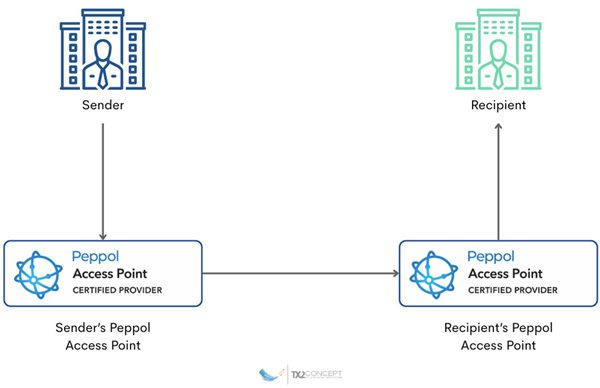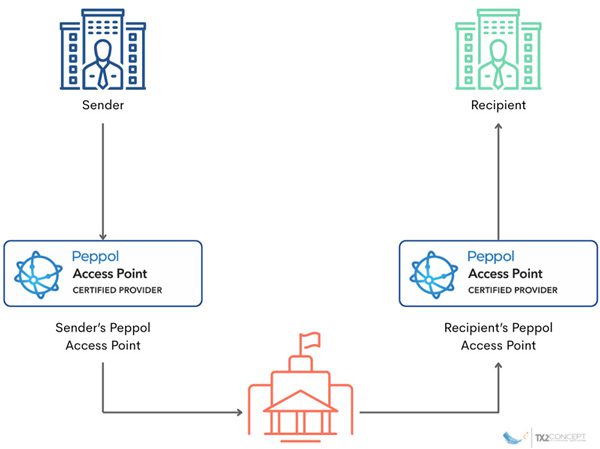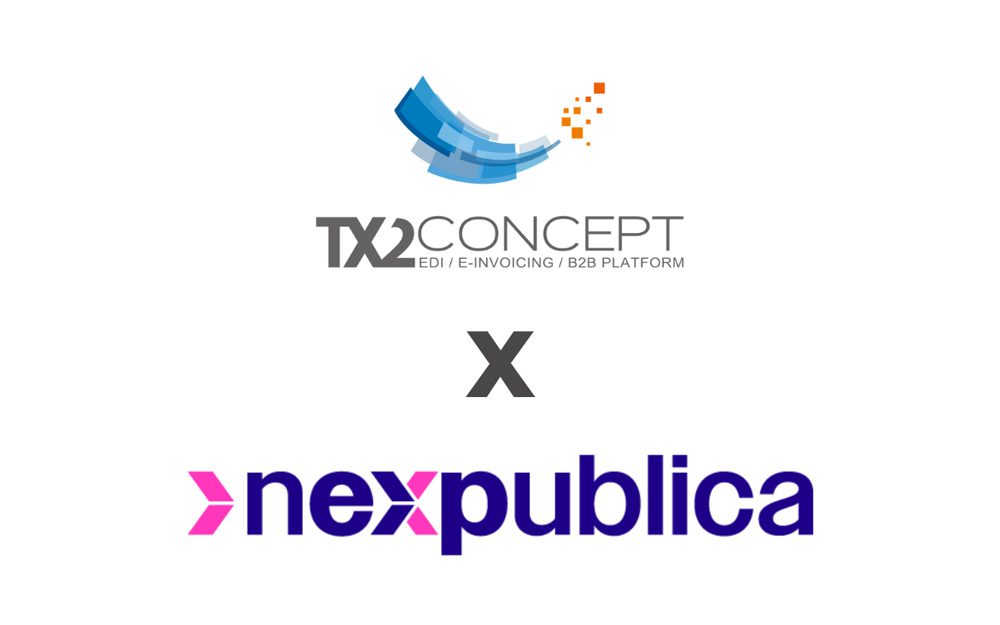Contents :
- Peppol: what is it?
- What is OppenPeppol?
- How the Peppol network works
- Peppol and the French e-invoicing reform
- Definition of the French Peppol authority
- The benefits of the PEPPOL network
- TX2 CONCEPT is PEPPOL Access Point
At a time of digital transformation and paper reduction, electronic invoicing is becoming an essential standard for companies and public administrations. The Peppol network is a key player in this revolution.
This article gives you a complete overview of this network, how it works, and its role in electronic invoicing, particularly in France and Belgium.
Peppol: what is it?
The Peppol (Pan-European Public Procurement On-Line) network is an international infrastructure that facilitates the exchange of standardized business documents between companies and public administrations. Designed to facilitate the exchange of data between players, Peppol is at the heart of the digital transformation of purchasing and invoicing processes.
By simplifying communication between public and private players, Peppol helps to make commercial transactions more transparent, secure and efficient.
The creation of the Peppol network
Created in 2008 as part of a European initiative, Peppol was initially aimed to standardize data exchanges in the public and private sectors. Designed to facilitate public invitation to tenders in Europe (B2G), it has gradually evolved to include all types of business-to-business (B2B) transactions.
Today, it is used in many countries around the world.
Peppol on the international scene
Although initiated by the European Union, Peppol has quickly spread beyond Europe’s borders. Countries such as Australia, Canada and Singapore have integrated it into their electronic invoicing systems, creating a truly international system.
Today, around forty countries use it.
Peppol is at the heart of certain reforms concerning the obligation of electronic invoicing between companies. This is particularly the case in Belgium.
From January1, 2026, all Belgian companies and those registered for Belgian VAT will have to dematerialize their B2B invoice flows in accordance with the Peppol BIS 3.0 standard, and exchange them via this system. An exception is made for EDI flows, provided that both partners agree and that the invoices comply with EN16931-1 and CEN/TS 16931-2 standards.
What is OppenPeppol?
OpenPeppol is an international association that manages and oversees the development of the network. It oversees the conformity of access points, the evolution of technical standards and the governance of the network.
Members of this association, including companies and public institutions, work together to promote the adoption of Peppol worldwide.
National Peppol authorities work in conjunction with OpenPeppol, which delegates certain tasks to them.
How the Peppol network works
Peppol is based on an interconnected model in which partners, known as“access points“, facilitate the secure exchange of electronic documents.
To receive their invoices, companies and public bodies must be registered in the Peppol directory.
Its architecture is as follows:
4-corner model
The 4-corner model is Peppol’s basic principle.
Two entities, for example, a company and a public administration, exchange documents via interconnected access points. Each side, or “corner”, represents an actor: the sender, the recipient and their respective access points.

5-corner model
Also known as Peppol CTC, for Continuous Transaction Controls, the 5-corner model is a response to the new tax reforms appearing in many countries. Indeed, in this model, a 5th player appears: a central platform, generally public and state-owned.
In France, for example, this platform would be the Public Invoicing Portal (PPF in french).
This model enables real-time flow control.

Peppol directory
As mentioned above, companies must be registered on the directory in order to receive their documents. To register, companies must enter their Peppol ID. This ID uniquely identifies each recipient. It may correspond to the SIRET number, as is the case in France, or to the VAT number, for example.
To find out whether the recipient of your document is on the Peppol network, you need to query this directory.
What messages are exchanged on Peppol?
The Peppol network is mainly known and used for the exchange of electronic invoices via the Peppol BIS Billing message.
But there are many other Peppol BIS messages, such as Billing Credit Note, Invoice Response, Order Only, Ordering, Advanced Ordering, Order Agreement, Punch Out, Despatch Advice, Catalogue with or without response, etc.
What formats are used on Peppol?
All types of formats can be exchanged via Peppol: EDIFACT, Factur-X, ZUGFeRD for Germany… On the other hand, there is a certain consensus around the use of the UBL XML format.
For example, for electronic invoicing, the vast majority of exchanges today use the Peppol BIS Billing 3.0 format, a UBL format based on the EN 16931 standard.
What is a Peppol access point?
A Peppol access point is an intermediary service enabling a company to connect to the Peppol network. It receives, validates and sends electronic documents, while guaranteeing compliance with Peppol technical standards.
There are several hundred of them worldwide. Each of these providers must pass certification tests to become a Peppol Access Point.
TX2 CONCEPT is certified Peppol access point since 2019.
Peppol and the French e-invoicing reform
The French e-invoicing reform will require all companies to send their invoices electronically via PDPs from September 2026. In particular, this will enable the tax administration to combat VAT fraud and to have real-time knowledge of economic activity. For more information on the regulations, please consult our articles on the subject.
In this context, the Peppol network plays a key role, offering a reliable and secure solution for interoperability between all PDPs. Suppliers’ PDPs will transmit invoices to their customers’ PDPs via Peppol. At the same time, the PDPs will send invoice and e-reporting data to the Public Invoicing Portal (PPF).
That’s why one of the Afnor Electronic Invoicing Commission’s working groups is focusing on integrating the Peppol network into future invoicing processes.
Definition of the French Peppol authority
In France, as part of the e-invoicing reform, the DGFiP has announced its intention to become the French Peppol Authority. It will thus be responsible for setting up and managing the Peppol network in France. At the date of publication of this article, this change is still in progress.
Its role would be to create a common framework for all PDPs, to facilitate and promote interoperability between platforms and their coordination around this central entity.
These elements will be discussed by the Afnor Electronic Invoicing Commission, whose work will be published by summer 2025.
The benefits of the PEPPOL network
The advantages of its adoption are multiple:
- Standardization: Reduces fraud and facilitates trade.
- Efficiency: Reduces costs and human error.
- Security: Guarantees the protection of exchanged data.
- Interconnectivity: Simplifies connections between national and international players.
TX2 CONCEPT is PEPPOL Access Point
As mentioned above, TX2 CONCEPT is a certified Peppol access point, offering a turnkey solution for connecting your company to the Peppol network.
Thanks to our expertise, we can help you integrate electronic invoicing and ensure smooth, secure and compliant management of your commercial document exchanges.
As a reminder, we are also a registered Partner Dematerialization Platform (PDP n°15). We can support you in your compliance efforts with a solution tailored to your needs, in France, Belgium and many other countries.
The Peppol network is establishing itself as an essential solution for electronic invoicing. How do you plan to integrate it into your invoice management processes?
Don’t hesitate to contact us or schedule an appointment with one of our experts to discuss your project. They’ll be delighted to advise you and introduce you to our services.

